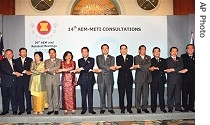2007年VOA标准英语-ASEAN Ministers Near Trade Deal with Japan, Adv
搜索关注在线英语听力室公众号:tingroom,领取免费英语资料大礼包。
(单词翻译)
By Chad BouchardJakarta
25 August 2007
Economic ministers from the Association of Southeast Asian Nations and Japan have put the final touches on a free-trade deal, one of the largest in Asia. The ASEAN officials also have agreed on a blueprint1 that would create a seamless regional economy by 2015. Chad Bouchard reports from Jakarta.
 |
| ASEAN economic ministers during a photo session after their 10th Economic Ministers Meeting with their three dialogue partners China, Japan and South Korea, 25 Aug 2007 |
In return, ASEAN's wealthier six nations will cut tariffs on 90 percent of Japanese goods. The four smaller, impoverished3 members - Burma, Cambodia, Laos and Vietnam - will make cuts later and more slowly.
Trade ministers gathered in Manila for a three-day meeting say the deal will sharply increase trade between ASEAN and Japan, which already tops 160 billion dollars.
While ASEAN is making progress on trade deals with Japan, China and other countries, it is also making progress in expanding internal trade. On Friday, the ASEAN ministers approved a blueprint for creating a free-trade zone by 2015.
The ASEAN Economic Community, or AEC, hopes to form an integrated group like the European Union, which can stand up to trade giants such as China and India.
University of Adelaide Economics Professor Christopher Findlay says the blueprint may not be enough to lure4 investors5 to the region. He says key components6 such as infrastructure7 and product standards will have to be addressed more rigorously.
"Yeah, so it's okay to make commitments about border change, and it's really important to do that, and the gains from getting that right are huge. But there's strategy in actually implementing8 it. I think what we're discovering is that you need to be thinking about what's happening behind the border as well," said Findlay.
Discussion over trade in the agriculture sector9 has been sidelined due to a stalemate over farm subsidies10 and trade barriers.
Findlay says that since farm products dominate the export market in Southeast Asia, the AEC trade agreement is weakened by their exclusion11.
ASEAN is made up of 10 countries - Brunei, Burma, Cambodia, Indonesia, Laos, Malaysia, the Philippines, Singapore, Thailand and Vietnam - with a combined gross domestic product of one-point-one trillion dollars.
The group has been hammering out trade deals with six countries, including Japan and China, which are to be finalized12 this year.
The guidelines for the ASEAN Economic Community are expected to be signed during the group's summit in Singapore this November.
 收听单词发音
收听单词发音 




